John Hurrell – 22 January, 2021
The works' individual subtitles (in brackets) reference building exteriors and interiors, terms such as such as corridor, pathway, gate, alleyway, gate, frame, apartment and hinge. Some of the images clearly reference these. Despite this, the crisscrossing vectors emphasise the picture-plane; your eye is not sucked towards the wall. There is no deep receding space. Just fleeting hints.
Australian artist, Will Cooke‘s first New Zealand show features nine black, white and grey abstractions that use grids of aluminium metal circles that float in front of architectural configurations of vertical, diagonal and horizontal edges—some soft and fuzzy (from an airbrush); others severe, hard and sharp. In scale the vertical rectangles have sufficient impact to affect you bodily. They suit the large Starkwhite downstairs space perfectly.
The works’ individual subtitles (in brackets) reference building exteriors and interiors, terms such as such as corridor, pathway, gate, alleyway, gate, frame, apartment and hinge. Some of the images clearly reference these. Despite this, the crisscrossing vectors emphasise the picture-plane; your eye is not sucked towards the wall. There is no deep receding space. Just fleeting hints.
With the dull silver metal discs—the works are painted on aluminium so that the unpainted circles peek through—their tone subtly changes according to the reflecting angle of the light. Like the angular ‘scaffolding’ behind them, they radiate instability. All the lines are dead straight, apart from the edges of the nine hovering circles, yet often they appear to bend. Some diametrically opposed corners disappear into mist.
Because of their theatrical use of illuminating light and impenetrable darkened form, and symmetry that turns them into chunky glyphs, these dramatic industrial paintings—with spiky shapes—have a fetishistic quality: they seem to be vibrating living entities. The angular forms seem inhabited.
Part of the motivation for these optically compelling creations is Will Cooke’s admiration for the great modernist designer and architect Jean Prouvé. Cooke has found inspiration in the Ralph Waldo Emerson quote he uses as a title and a link to Prouvé. One of Prouvé’s trademarks is a grid of cut-out circles on a light metal wall.
Cooke’s dynamic arrangements of black and white triangles—set behind the discs—organised in piercing acuity with tremulous edges and competing compositional halves, are more than just examples of design that is visually satisfying. There is a restless turbulent energy revolving around the nine flickering and bobbing dots that demands attention, that keeps you locked in with full ocular and mental absorption.
John Hurrell

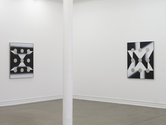
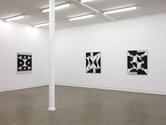
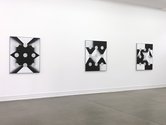
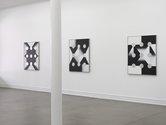
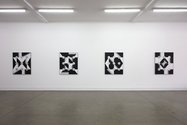
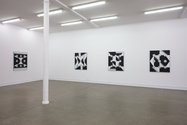
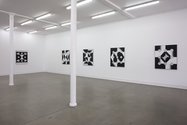
 Two Rooms presents a program of residencies and projects
Two Rooms presents a program of residencies and projects Advertising in this column
Advertising in this column



This Discussion has 0 comments.
Comment
Participate
Register to Participate.
Sign in
Sign in to an existing account.